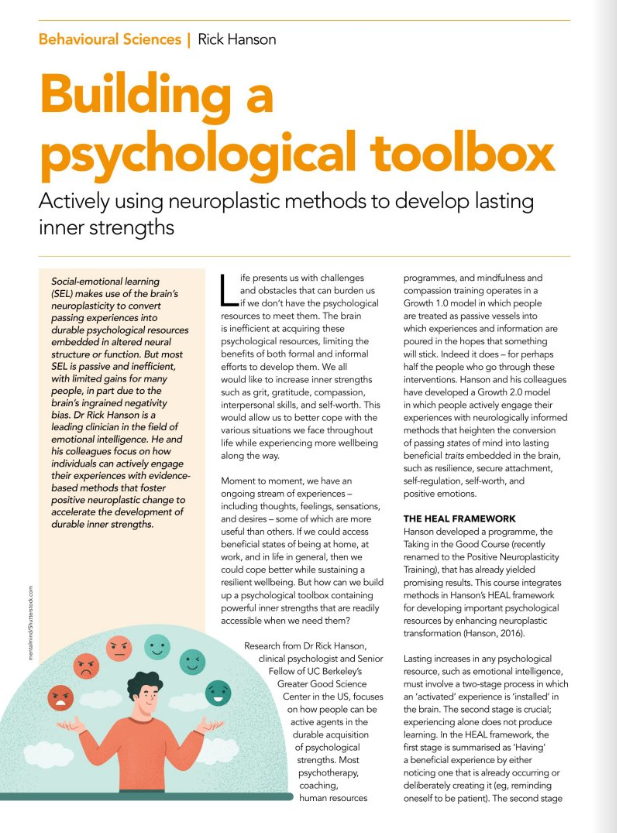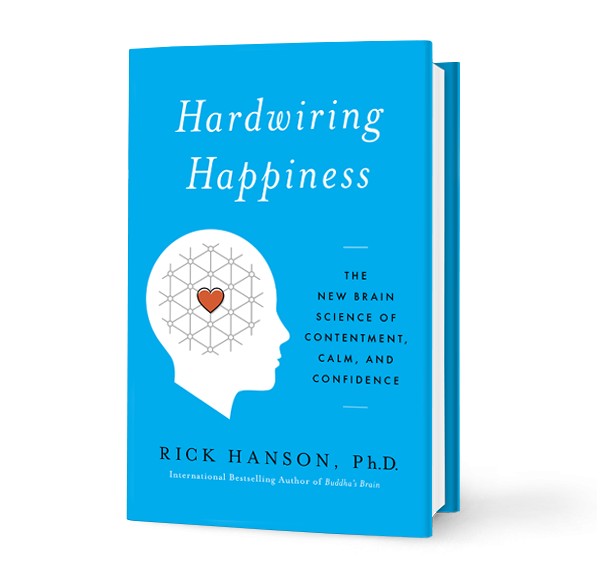Good Change that Lasts
“The science of positive neuroplasticity shows that every person has the power to change their brain for the better.”
Rick Hanson, Ph.D.

Learn About Positive Neuroplasticity
Resources for learning about experience-dependent neuroplasticity.

Apply Positive Neuroplasticity to Life
Resources, templates, stories, and other good stuff for individual, community, and global practice.

Teach Positive Neuroplasticity to Others
Join teachers from 12 countries around the world who teach the science of positive brain-change to help others.

Dr. Rick Hanson
A leading expert in positive neuroplasticity and creator of the Positive Neuroplasticity Training, Dr. Rick Hanson is a psychologist, Senior Fellow of UC Berkeley’s Greater Good Science Center, and New York Times best-selling author.
Dr. Hanson’s Groundbreaking Study on Brain Neuroplasticity
Read About the Study:
Research Outreach
“Building a Psychological Toolbox: Actively Using Neuroplastic Methods to Develop Lasting Inner Strengths”
Published: August 2022
Learning to Learn from Positive Experiences
Webinar
Dr. Rick Hanson offered a webinar on February 8, 2022, providing an overview of his paper published by the Journal of Positive Psychology, Learning to Learning from Positive Experiences. The study showed that deliberately internalizing beneficial experiences can lower anxiety and depressed mood, and increase gratitude, self-compassion, and happiness in general.
Read About the Study:
Oprah Daily
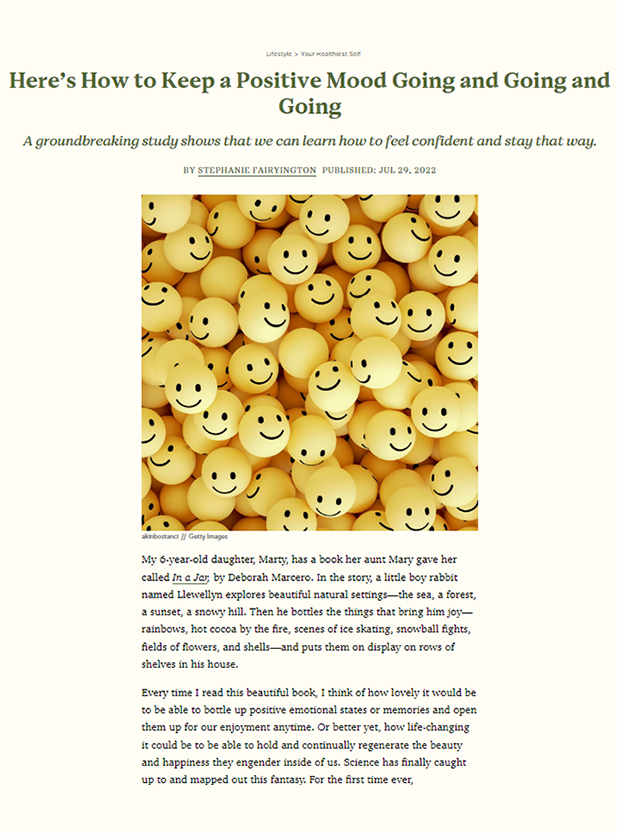
“Here’s How to Keep a Positive Mood Going and Going and Going” by Stephanie Fairyington
Published: July 29, 2022
The Brain’s Negativity Bias
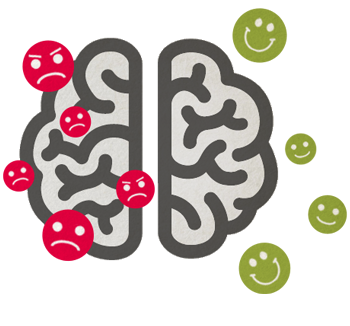
Our brains are wired to take in the bad, and ignore the good.
Did you ever notice that it’s easier to ruminate over hurt feelings than it is to bask in the warmth of being appreciated?
That’s because our brains evolved to learn quickly from bad experiences, and slowly from good ones.
But we can change this.
Using the science of positive neuroplasticity, we can override the brain’s negative tendencies and tap the hidden power of everyday experiences to build new neural structures that promote happiness, love, confidence, and inner peace.
Watch Dr. Rick Hanson explain the basics of Positive Neuroplasticity
Want to use positive neuroplasticity in your work with others?
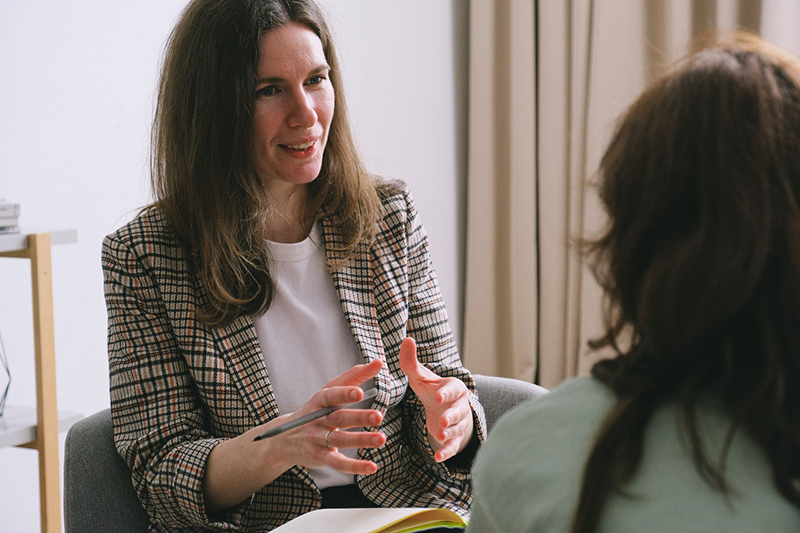
The Professional Course is hands-on and practical, showing you how to apply these powerful methods in your work with others. It’s designed for therapists, coaches, educators, healthcare workers, mindfulness trainers, and more.
Prefer to take a live Positive Neuroplasticity Training class?

The Positive Neuroplasticity Teachers Association (PNTA) accredits teachers worldwide to deliver the 18-hour Positive Neuroplasticity Training. Learn the techniques in the dynamic environment of your peers with a qualified teacher in your locale.
Would you like to teach the Positive Neuroplasticity Training?

Upon completion of the PNT and Professional Course, you’re invited to apply to teach the PNT yourself. Qualified individuals join the PNTA and have full access to PNT materials, as well as trainings and support from Rick Hanson.
Read about the New Brain Science of Contentment, Calm and Confidence
Dr. Hanson’s 2013 classic has become the go-to source on positive neuroplasticity. It reveals the simple yet effective 4-step process for beating the brain’s negativity bias — the bias evolved to help ancient animals survive, but today makes us feel needlessly frazzled, worried, irritated, lonely, inadequate, and blue.
The good news is that in just a few seconds at a time in the flow of daily life, you can turn your experiences into lasting inner strengths built into your brain, such as resilience, balance, and positive emotions.
Grounded in neuroscience, this book is super practical, full of easy-to-use methods and guided practices to grow a steady well-being, self-worth, and inner peace. And it has special sections on children, motivation, relationships, trauma, and spiritual practice.
Learn how to manage your Stone Age brain in the 21st century – taking in experiences of your core needs being met, so that you gradually leave the “red zone” of fight-flight-freeze stress and get centered in the brain’s “green zone” in which you feel an ongoing sense of ease, fulfillment, and love – even while you deal with life’s challenges.
Frequently Asked Questions
Dr. Hanson answers questions about positive neuroplasticity
What is the basic premise of your work on positive neuroplasticity?
My work – and that of many other scholars and clinicians – is grounded in the general fact of “experience-dependent neuroplasticity,” which is the capacity of mental activity to change neural structure.
A traditional saying is that the mind takes the shape it rests upon. The modern update would be that the brain takes its shape from whatever the mind rests upon – for better or worse. The brain is continually changing its structure. The only questions are: Who is doing the changing: oneself or other forces? And are these changes for the better?
In this larger context, my focus is on how to apply these new scientific findings: how to use the mind to change the brain to change the mind for the better – for psychological healing, personal growth, and (if it’s of interest) deepening spiritual practice. I’m especially interested in:
- How the brain has been shaped by evolution, giving us problematic tendencies toward greed, hatred, heartache, and delusion (using traditional terms) as well as wonderful capacities for happiness, peace, love, and wisdom. For example, we have a brain that makes us very vulnerable to feeling anxious, helpless, possessive, fixated on short-term rewards, angry, and aggressive. These qualities helped our ancestors survive and pass on their genes, but today they lead to much unnecessary suffering and conflict on both personal and global scales.
- “Neurologizing” the deep Buddhist analysis of the mind: what is going on inside the brain when a person is caught in the craving that leads to suffering? Alternately, what is happening in the brain when a person is experiencing equanimity, lovingkindness, meditative absorption, or liberating insight?
- Using neurologically-informed methods to help overcome our ancient inclinations to fear, dehumanize, exploit, and attack “them” so that 7 billion of us can live in peace with each other on our fragile planet.
In sum, this brain stuff can sound exotic or esoteric, but in essence the approach is simple: find the neural processes that underlie negative mental factors, and reduce them; meanwhile, find the neural processes that underlie positive mental factors, and increase them. Less bad and more good – based on neuroscience and Western psychology, and informed by contemplative wisdom.
What changes in our brains when we repeatedly focus on the way we think and react to situations?
In practical terms, learning – brain change – is a two-stage process in which an activated experience must be installed through some kind of lasting change in neural structure or function. We become happier through having repeated experiences of happiness and related factors that get encoded – installed – into the brain.
Without installation, there is no learning, no change: in effect, the experience is wasted on the brain. This is the dirty little secret in most psychotherapy, human resources training, coaching, addiction recovery, and character education: most hard-won beneficial states of mind are momentarily positive but have no lasting value. That’s why many efforts to develop deep inner strengths in people are largely if not completely ineffective: they are indeed being fostered – but without deliberate mindful attention to sustaining them, feeling them in the body, and intentionally absorbing them into oneself, they just don’t get encoded much into the brain. The person may have a memory of a harrowing sailing trip or an intense week with Outward Bound, but is still basically just as vulnerable to stress, loss, or setbacks as ever because they didn’t “take in” those experiences.
The good news is that this skillful attention can be readily developed, as we found in the research on my training in positive neuroplasticity, and as explored in Hardwiring Happiness. But we have to do the work 5, 10, 20 (usually enjoyable) seconds at a time. Then we know in our hearts that we have earned the results – which makes the strength that we develop even sweeter.
Can we hardwire our brains to be grittier the same way we hardwire them to be happier?
Any kind of learning – including emotional, social, motivational, and character learning – must involve changes in the brain. This means that grit – resilience, determination, persistence, hardiness, courage – gets developed through changes in neural structure and function. We develop more grit through having repeated experiences of determination, endurance, resolve, perseverance, and sheer survival that get woven into the fabric of the brain – and thus one’s life.
Can anyone develop a “buddha brain” — even people struggling with mental illness or depression?
Definitely!
Second, we all must begin the path wherever we are – whether that’s everyday stress and frustration, mental illness, anxiety, sorrow and loss, or depression. In any moment when we step back from our experience and hold it in mindful awareness, or when we begin to let go of negative feelings and factors, or when we gradually turn toward and cultivate positive feelings and factors we are taking a step toward developing a buddha brain. Each small step matters. It was usually lots of small steps that took a person to a bad place, and it will be lots of small steps that take him or her to a better one.
Third, mental anguish or dysfunction can help us grow. They teach us a lot about how the mind works, they can deepen compassion for the troubles and sorrows of others, and, frankly, they can be very motivating. Personally, the times in my life when I have been most intent on taking my own steps toward a buddha brain have been either when I was really feeling blue – and needed to figure out how to get out of the hole I was in – or when I was feeling really good, and could still sense that there had to be more to life than this, and more profound possibilities for awakening.
How could you measure clinical interventions that encourage new cell growth and happiness?
This question gets at the remarkable fact under our noses all day long: our ineffable thoughts and feelings are making concrete, physical, lasting changes in the structure and function of our brains. Neurons that fire together, wire together. This is learning, including the emotional, motivational, attitudinal and skills learning that is our focus in therapy. In other words, the making of memory – especially implicit memory, the storehouse of emotional residues of lived experience, knowing “how to,” expectations, assumptions, models of relationship, etc. distinct from explicit memory, the much smaller storehouse of specific recollections and knowing “about” – the gradual change of the structure and function of the brain.
In this context, any kind of mental change is evidence of neural change. Since neuroscience is a baby science, our current, noninvasive, imaging technologies have limited capacities to measure neural change in human beings – especially given how physically fine, fast, and complex these changes are. You could put five of the cell bodies of a typical neuron side by side in the width of just one of your hairs, and five thousand of the synapses, the connections, between neurons in the width of just one hair.
Nonetheless, even though the ethics of animal research trouble and even alarm many, including me, it is the case that more invasive research on animal learning – including emotional, motivational learning, that has some parallels to therapy – has established many fine-grained details of the ways in which experiences of stress, frustration, and trauma, as well as experiences of caring, success, and safety change the nervous system.
So we presume that neural change must be occurring if there is mental change. In this light, there are now many studies with human beings that show structural and functional changes after interventions such as training in mindfulness, compassion, body awareness, and psychotherapy. The cortex – the outer shell or “skin” of the brain – gets measurably thicker due to new synapses and greater infusion by capillaries for blood flow; key regions are more readily activated; there is also greater connectivity between regions, so they are more integrated and work better together; there are even changes in the expression of genes – tiny strips of atoms in the twisted up molecules of DNA in the nuclei of neurons.
And as your mind changes your brain for the better, these changes in your brain feed back to change your mind for the better as well. As these positive structural and functional changes in the brain occur, people become more capable and happy. For instance, training in mindfulness increases activation in the left prefrontal cortex, which supports a more positive mood.
As to new cell growth, I assume this is a reference to neurogenesis, the birth of new baby neurons, primarily in the hippocampus. We can encourage the birth of these neurons through exercise, and encourage their survival and wiring into memory networks through engaging in complexity and stimulation.
Here’s the takeaway: we can be confident in our own lives, and in our work with clients, that our efforts are bearing fruit in actual, physical changes in the nervous system. And since motivation is one of the primary factors shaping outcome in psychotherapy – and in life as a whole – this is heartening, wonderful news.
In your understanding, what are the limits of brain plasticity?
Most neuroplasticity is subtle and local, and does not change the overall architecture of the brain. I also think it is possible that there are individual variations in organic capacity for changing the brain, though I haven’t seen any studies on that (though they may exist).
I think a good starting point is to consider the vast diversity of human cultures, and the many individual examples of vast psychological changes – for better or worse – over the course of one person’s life. These illustrations of great mental plasticity are evidence for great neural plasticity in high impact ways, even if the vast majority of the synapses and circuits of the brain are unchanged.
The takeaway for me from this line of thinking is to appreciate the importance of hard work, of making little efforts each day that add up over time, to change your brain and thus your life for the better. And there’s a takeaway in terms of never betting against human potential and the human heart. Most of us have no idea how much we could grow psychologically or spiritually if we really gave ourselves to it, and put at least as much effort into it as we put into our occupation – or even our golf game!
How is the brain changed specifically by doing the practices you suggest?
As a broad principle, the brain regions or processes that are activated by an experience are the ones whose structure or function is most likely to be changed by the activation.
Neuroscience is a baby science, with much that’s not known. There’s much that may be plausible that doesn’t yet have a specific study to back it up.
This said, the conceptual, perspective aspects of the practice of reminding yourself mentally that everything is impermanent would tend to engage prefrontal areas that do conceptual processing, and with repetition and conviction, produce lasting changes there, i.e., learning, adopting, developing the habit of a new view.
Also, the physical and emotional relaxation that would come with accepting transience would likely involve decreased sympathetic nervous system activity, increased parasympathetic nervous system activity, decreased stress hormones, and increased reward- and pleasure-related neurotransmitter activity (e.g., dopamine, natural opioids). With repetition, duration, and intensity of the experience, there would tend to be gradual changes in the resting state and responsiveness of these neural processes.
Last, evidence of mental change is evidence of neural change. Otherwise we are left with supernatural explanations. So if a person feels different or acts differently, something must have changed at the level of the body, particularly the brain.
What evidence or experience do you have to support your claims about positive neuroplasticity?
There is tremendous evidence in published studies on psychological practices or interventions of various kinds – including the kinds I mention, notably relaxation and positive emotion practices – that they do lead to significant improvements in mental health indicators of various kinds: improvements that do change lives for the better in meaningful ways.
- There is also tons of evidence in research studies about the effects of frequency of spaced practice and the effects of personal effort. One implication is that for people who do not experience a benefit that changes their life in a meaningful-to-them way, are exceptions to that rule because they did not actually practice whatever it was (e.g., mindfulness, gratitude) a few times a day, day after day after day.
- Distinct from published research, I’ve received many anecdotal reports that my statement was true for them. This is evidence of a kind.
- I have personally experienced that my statement is true. An N of 1, for sure, but still definitely the evidence of my own experience.
As a personal detail, I worked for a year for a mathematician who did probabilistic risk analyses, and it was a fascinating consideration of levels of evidence for propositions about reality. As is increasingly noted in the scientific community, including the life sciences and social sciences, the dichotomous true/false distinction of “statistical significance/non-significance” is mathematically silly. The crux is how much uncertainty we have about propositions. Then the question becomes, to what extent do certain kinds of evidence reduce uncertainty. By the definition of information, relevant information of any kind reduces uncertainty. Information comes from many sources, most of which are not randomized control group double-blind studies. For example, roughly half of the methods used routinely in medical settings do not have a study behind them, but they are within the standard of care because there are other kinds of evidence for their legitimate use.

